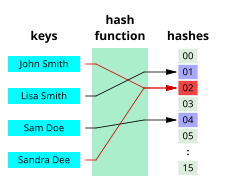Hashing: Data Privacy and Authentication
Today’s post is going to be dedicated to “hashing”, a term used pretty loosely in the computer science field, yet one that is an absolute must-know if you’re ever going to be a serious developer.
If you haven’t heard of hashing or have no experience with the topic, consider this read my treat. I will describe the function of hashing, what it is used for and why, and demonstrate how to use it with examples in Python and Java.
What is Hashing?
A hash function, or algorithm, is a one-way function that transforms
an input data of any size into a fixed-size output, called the “hash.”
It’s very important to realize that a hash function is a one-way function;
that means you cannot get the original input back after you’ve hashed it.
The reason for this, is the hash function has the potential for collision.
Collision is when two or more inputs yield the same output, as the following
diagram from the wikipedia page:

Different hash algorithms will have different probability for collision, but it’s important to acknowledge they all exhibit the quality. If you consider the definition of the hash function as I just described, this unavoidable risk of collision is more understandable–the range of inputs (any size data) outweighs the range of outputs (a fixed size).
Why Use Hashing?
Before answering this question, allow me to show what the actual data might
look like when hashing. The input might be just a string such as "foobar"
and the hash output might be 8843d7f92416211de9ebb963ff4ce28125932878.
Hashing is used for three primary purposes (this list is not exhaustive):
- Obfuscating private data (e.g. Personally Identifiable Information (PII))
- Authenticating, or verifying, submitted data (e.g. secure password management)
- Building caches and data structures for large data sets
For example, a typical password management approach, while not 100% unbreachable, is to generate a salt (a random sequence of bytes) and hash the salted password, store that hash, and when a login request comes in, you can verify by salting the inputted password and comparing its hash with your stored hash:
// Create account
salt = generateSalt()
passHash = hash(salt + password)
store(username, salt, passHash)
// Authenticate login
salt = getSalt(username)
expectedHash = getHash(username)
formedHash = hash(salt + passwordInput)
return (expectedHash == formedHash)In that scenario, the storage is arbitrary so store(...) might store
the data in a relational database or whatever other storage entity you’re using.
The same goes for fetching the data with getSalt(...) and getHash(...).
Common Hash Functions
Now that we’ve covered the basics of hashing, what hash functions, or algorithms, are available to us and which one is right for you? It all depends on the context. Below is a table of a few of the most commonly used hash algorithms, their attributes, and what they’re commonly used for:
| Hash Algorithm | Attributes | Uses |
|---|---|---|
| SHA1 | 160-bit (20 bytes); medium speed; minimally secure | minimal security of data rest; data verification |
| SHA-256 | 256-bit (32 bytes); not-the-fastest; more secure than SHA1 | good security of data at rest; good authentication; data verification |
| SHA-512 | 512-bit (64 bytes); slow; very secure | very strong data security for data at rest; strong authentication; data verification |
| MD5 | 128-bit (16 bytes); very fast; not secure | data verification (checksums) |
| PBKDF2 | variable length; used in conjunction with SHA; iterative hashing | excellent for password storage |
| Bcrypt | variable length; used in conjunction with other hash algorithms | excellent for password storage |
Examples
Most languages have built-in support for hashing, and as you’ll see in the examples below it is very straight-forward.
Python (3.x)
#!/usr/bin/env python3
import hashlib
# SHA-1
sha1 = hashlib.sha1()
sha1.update('foobar'.encode('UTF-8'))
print(sha1.hexdigest()) # 8843d7f92416211de9ebb963ff4ce28125932878
# SHA-256
sha256 = hashlib.sha256()
sha256.update('foobar'.encode('UTF-8'))
print(sha256.hexdigest()) # c3ab8ff13720e8ad9047dd39466b3c8974e592c2fa383d4a3960714caef0c4f2
# SHA-512
sha512 = hashlib.sha512()
sha512.update('foobar'.encode('UTF-8'))
print(sha512.hexdigest()) # 0a50261ebd1a390fed2bf326f2673c145582a6342d523204973d0219337f81616a8069b012587cf5635f6925f1b56c360230c19b273500ee013e030601bf2425
# MD5
md5 = hashlib.md5()
md5.update('foobar'.encode('UTF-8'))
print(md5.hexdigest()) # 3858f62230ac3c915f300c664312c63f
Java
// SHA-256
MessageDigest sha256 = MessageDigest.getInstance("SHA-256");
String text = "foobar";
sha256.update(text.getBytes(StandardCharsets.UTF_8));
byte[] sha256Digest = sha256.digest();
String hex = String.format("%064x", new BigInteger(1, sha256Digest));
System.out.println(hex); // c3ab8ff13720e8ad9047dd39466b3c8974e592c2fa383d4a3960714caef0c4f2
// MD5
MessageDigest md5 = MessageDigest.getInstance("MD5");
md5.update(text.getBytes(StandardCharsets.UTF_8));
byte[] md5Digest = md5.digest();
hex = String.format("%032x", new BigInteger(1, md5Digest));
System.out.println(hex); // 3858f62230ac3c915f300c664312c63f
Hopefully now you have a good understanding of hashing, and are prepared to use it where necessary. For more hashing-related topics check out the links below: